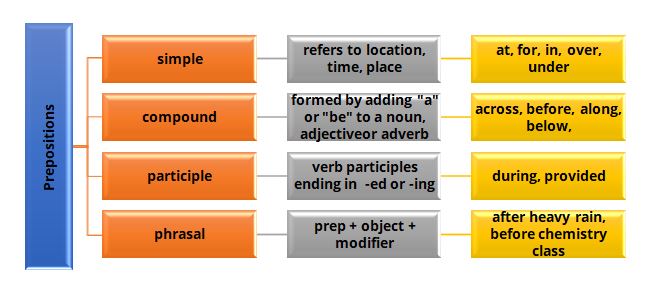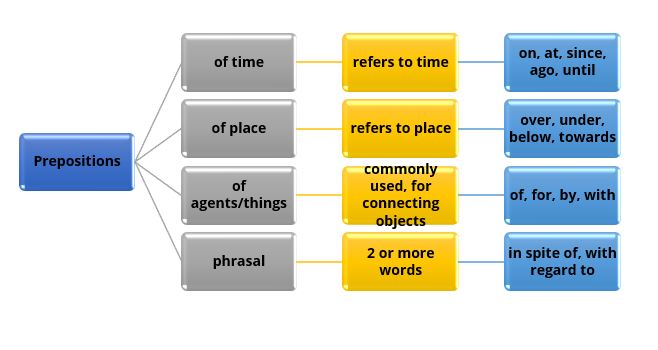PDF chapter test TRY NOW
A preposition is a linking word, that is placed before a noun (or a pronoun) and establishes the positional relationship with other words in the sentence.
In simpler words, a preposition is a connecting word, that links the noun/pronoun with the verb/adjective in the sentence.
Example:
She is sitting on a chair.
She - pronoun
Sitting - verb
On - preposition
Chair - noun
The preposition (on) connects the pronoun, verb and the noun.
Important!
Prepositions, as the name suggests, usually denote the position of the subject in the sentence.
Take a look at the following:
1. It usually rains in September.
2. I usually sleep early at night.
3. Since 2015, I have stopped eating sugar.
4. Before 2004, there were many problems in our society.
5. I'm on leave till 24th of this month.
The emphasized words establishes a connection between the noun and the other words in the sentence.
Prepositions are of different types. Let us look into each type in detail:

Here is a list of commonly used simple prepositions:
| at | in | by |
| under | over | on |
| beside | to | for |
| over | through | across |
| with | since | off |
| above | near | from |
Some of the compound prepositions are:
| about | above | below |
| along | across | amidst |
| around | before | behind |
| beside | between | beneath |
Here is a list of some participle prepositions:
| barring | concerning | considering |
| during | notwithstanding | pending |
| regarding | respecting | provided |
Here is a list of common phrasal prepositions:
| according to | in place of | with reference to |
| by means of | in spite of | in front of |
| for the sake of | with a view to | owing to |
| in lieu of | with regard to | instead of |
Prepositions can be classified on the basis of its functionality. The prepositions used are the same in both types of classifications.

Some of the examples from the lesson Fire: Friend and Foe:
- Long before he began to use fire himself.
- The oxygen in the air combines with fuel.
- When you blow on smouldering paper, it often bursts into flame.
- Every fuel has a particular temperature at which it begins to burn.
- We spend millions of rupees each year in fighting fires.
- Now there are laws about building construction.
- One of the three things needed for burning is taken away.
- If the temperature can be brought down below the flash point, the fuel stops burning.
- You remove the hot air around the flame.
- They can help people suffering from burns.
- Fuel and oxygen do not make fire by themselves.
- It only means that fire is very useful as long as it is kept under control.
